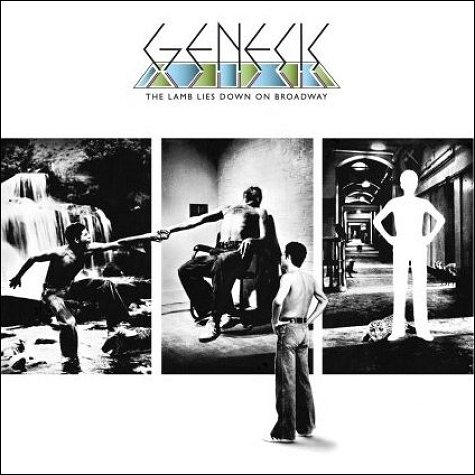
The Lamb Lies Down On Broadway (1974)

Disc One:
1.The Lamb Lies Down On Broadway
2.Fly on a Windshield
3.Broadway Melody of 1974
4.Cuckoo Cocoon
5.In The Cage
6.The Grand Parade of Lifeless
Packaging
7.Back In New York City
8.Hairless Heart
9.Counting Out the Time
10.The Carpet Crawlers
11.The Chamber of 32 Doors
Disk Two:
1.Lilywhite Lilith
2.The Waiting Room
3.Anyway
4.The Supernatural Anaesthetist
5.The Lamia
6.Silent Sorrow in Empty Boats
7.The Colony of Slippermen
8.Ravine
9.The Light Dies Down on Broadway
10.Riding the Scree
11.In The Rapids
12.It
It is often the case that a band, having achieved a measure of critical and commercial success, begins to feel the gravitational pull of The Concept Album. In 1974, Genesis—emboldened by a top 5 UK chart placement for Selling England by the Pound and the quiet satisfaction of having evolved from obscure schoolboys to art-rock royalty—decided that the time was ripe. Ripe, that is, to create something monumental. Something layered. Something entirely indecipherable.
Enter The Lamb Lies Down on Broadway—a double LP, narrative-driven epic that stands as both the pinnacle of Gabriel-era Genesis and, arguably, the moment where the edifice started to crack. The story, such as it is, follows a character named Rael (a Puerto Rican youth in New York City) through a series of surreal, metaphor-laden encounters. Whether these are dreams, hallucinations, or symbolic expressions of spiritual rebirth is beside the point—attempts at plot coherence tend to be met with blank stares or fiercely defended interpretations that border on the cultish. The album sleeve includes an accompanying text, purportedly to explain the proceedings. It does not.
And yet, for all this narrative opacity, the music is remarkably strong. Like most double concept albums—from Tommy to The Wall—the best approach is to submit to the flow, allowing the set pieces to emerge naturally from the ether. There are, inevitably, transitional oddities: snippets of noise, half-songs, and eerie interludes that serve little function beyond mood alteration and (in live settings) giving Peter Gabriel time to change into his latest sartorial fever dream. But these are mere detours.
When the album settles into proper song form, it does so with remarkable grace. The title track itself is compact and propulsive, one of the band’s most immediate moments. Fly on a Windshield and In the Cage follow with brooding atmosphere and visceral force, showcasing Banks’s arsenal of keyboard effects—ranging from evocative to downright peculiar. The Carpet Crawlers, with its gentle lilt and plaintive vocals, may well be one of the finest things Genesis ever recorded.
Indeed, it is Tony Banks who emerges as the record’s stealth protagonist. His sonic architecture—part cathedral, part carnival—provides the connective tissue throughout, while Steve Hackett’s contributions, though slightly more subdued than on previous outings, remain tasteful and precise. Gabriel, meanwhile, inhabits the material completely. His vocals are, by turns, snarling, delicate, bewildered, and ecstatic—precisely what the role requires, even if the role itself remains maddeningly undefined.
Critics at the time were, perhaps predictably, divided. Some admired the ambition; others found it overwrought and self-indulgent. Audiences, too, were perplexed. Genesis toured the album in full—a bold move, considering it left virtually no room for earlier fan favourites—and layered the performance with then-cutting-edge visuals and theatrical flourishes. The results were uneven. Technical hiccups abounded, and the narrative failed to translate, but the sheer audacity of the attempt won the band a certain reverence. At a time when “not getting it” was practically a badge of honour, The Lamb Lies Down On Broadway became something of a rite of passage.
Plans to revive the album in full surfaced around 2004, reportedly with all members willing except Gabriel. Perhaps the notion of reprising his role—once adorned in costumes ranging from a coffin-housed protagonist to a writhing colony of grapes—felt less like performance art and more like pantomime. Whatever the case, the reunion never materialized.
And so, The Lamb Lies Down on Broadway stands as the Gabriel-era swan song. His departure following the album’s tour seemed inevitable. This was, after all, the fullest realization of his vision—musically, theatrically, and conceptually. The band would carry on (and indeed, thrive), but never again would they attempt something so gloriously excessive, so wilfully impenetrable, or so defiantly artistic. That it remains revered—even as it continues to baffle—is testament to its peculiar brilliance.
Go back to the main page
Go To Next Review